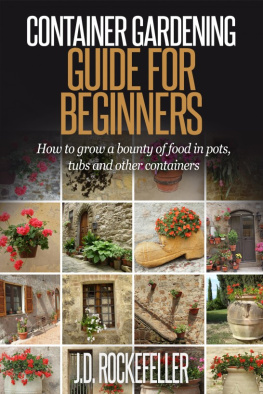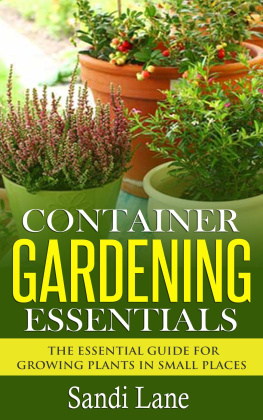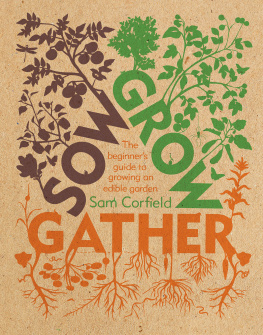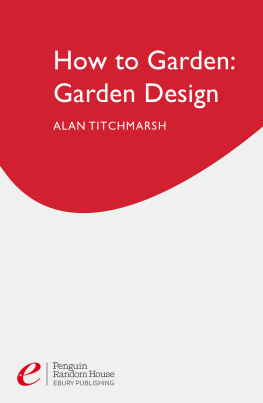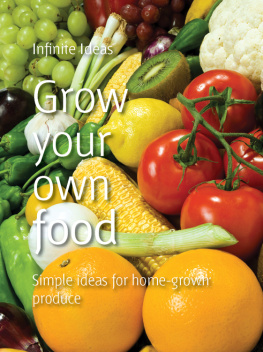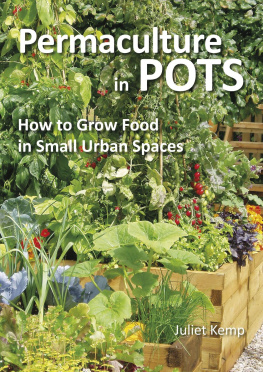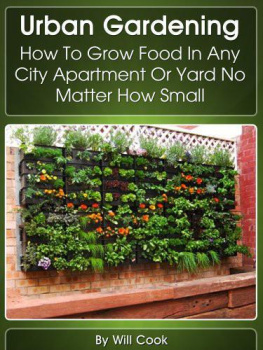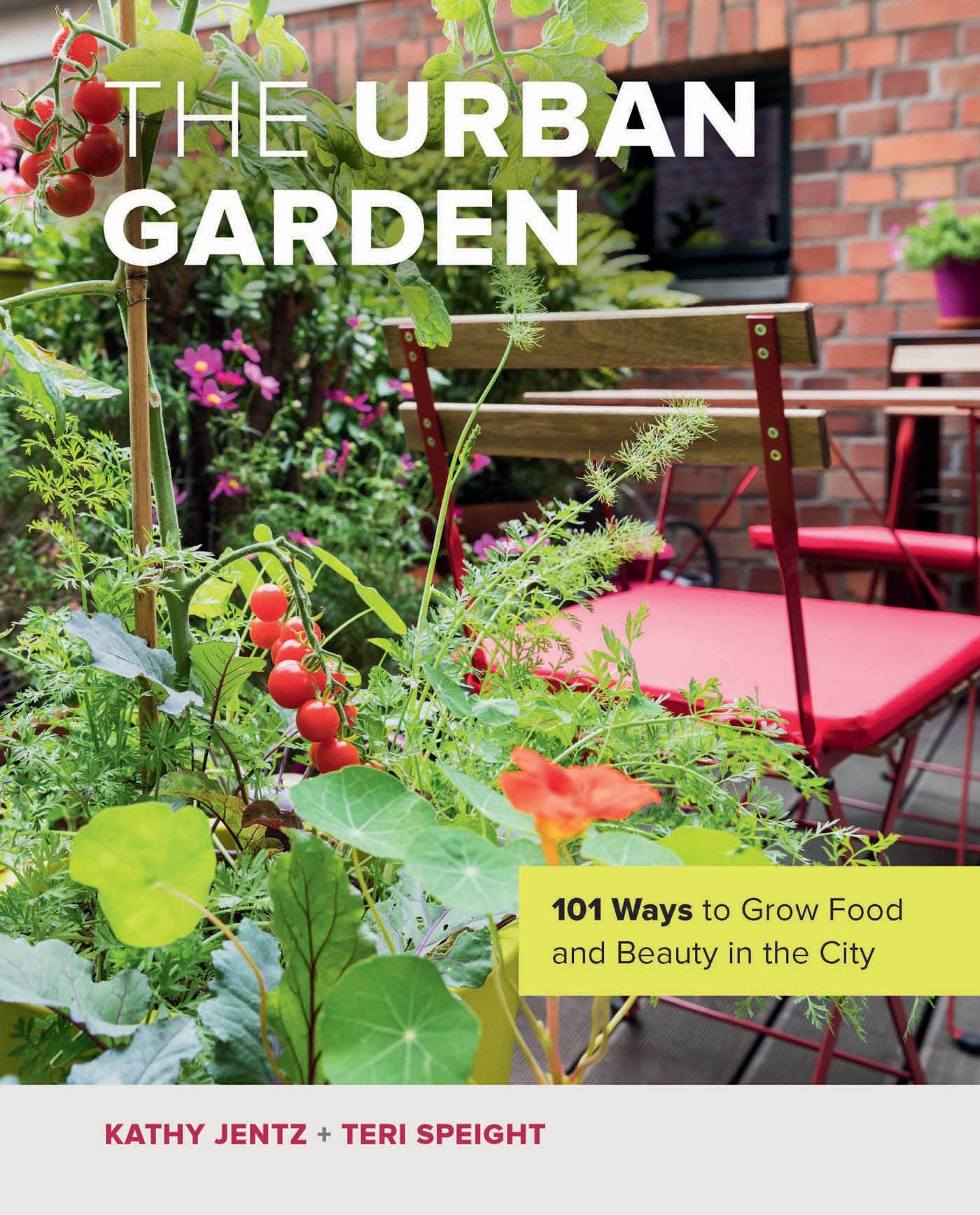Contents
Page List
Guide
Cover
THE URBAN GARDEN
101 Ways to Grow Food and Beauty in the City
KATHY JENTZ + TERI SPEIGHT
Contents
Introduction
All of us have limits. Whether it be the constraints on our personal time, budgets, or energy levels, there is a limit to how much we can personally garden. Small-space gardening is a fact of life for a majority of those living in urban neighborhoods and we often chafe against these boundaries, but as any good poet or artist will tell you, the permission to not have to tackle everything and focus on just one finite aspect of a topic is freeing. Because our urban spaces are limited, we dont need to worry about those big space choices like rotating fields of crops or maintaining an old-growth forest. Instead, we get to concentrate on creating tiny jewel boxes of perfection!
There are many creative ways to tackle urban gardening challenges. In this book, well take a look at clever methods for intensely gardening in tight areas, maximizing available growing spaces, and making the most of the benefits of raising plants in confined boundaries.
We also want you to be inspired by examples of beauty in urban gardens. This book is filled with images taken from cities all over the world that demonstrate how growing in constrained spots is not a limitation on creating a garden of beauty and bounty.
We are inspired by new and veteran gardeners who push the envelope of innovative ideas. The examples in this book are from our own decades of urban gardening experiences and gleaned from our pool of fellow green-thumb experts. Our goal is to encourage diversity by engaging those of you who are new to gardening and those who are already experienced urban gardeners.
You may have made some prior attempts at growing and have not been very successful at it. Dont let that discourage you. Here is a secret: All gardeners kill plants! That is how we learn. Each time we try is a chance to learn something new. The important thing is that we take note of what might have gone wrong, we adjust, and we try again. We hope that the examples and guidance in this book will help set you on the path of future success and continued learning.
Now, your green thumb is itching to get growing, but you dont have a big yard to dig into? Dont think a garden is out of reach! Instead, think creatively and explore the sunny outdoor spaces around your abode. Do you have access to a balcony, patio, or rooftop? How about a shared back alley or maybe you can rent an allotment plot? Growing spaces are all around you, once you start opening your eyes to them.
Sometimes the answer is a neglected green space that is in need of some TLC (tender loving care). Start asking around amongst your neighbors, coworkers, friends, and family. Many people have spaces to share that can be turned into gardens that they would be willing to lend for free or for a portion of the flowers or for some of the produce that you grow. Take that little step forward and ask!
Once you have carved out a bit of growing space foryourself, assess the growing conditions there. You will need to know the hardiness and heat zone, hours of sunlight, average rainfall, and any other factors that may impact plant health in your region. For example, is there an annual dry period? Are there prevailing winds? If you are growing in the ground, what is the texture and composition of the soil?
After you have determined these factors, you can start researching a plant list. This is where your personal tastes and ambitions come in. Maybe you love insects and animals and want an all-native garden to support local wildlife, or you love cooking and want to create the ultimate kitchen garden. Maybe you want a home and office filled with fresh bouquets of flowers that you have grown in your own garden from seed. Maybe you want to do all of these things! In the chapters ahead, well illustrate how to get started on those growing dreamsin the little spaces you have set aside to nurture them.
CHAPTER 1
Clever Containers
O PTIONS FOR PLANTING in containers have changed over time. In this chapter, we encourage you to think beyond the usual clay and ceramic pots. There are many new containers made from modern materials that will help the gardener in numerous ways. One example is self-watering pots to maintain hydration of the plant material. Another advantage is using moveable planters so you can have versatility in creating different planting combinations throughout the season.
Consider using alternative materials for a unique stackable container to plant a multitude of interesting plants. If you are short on space, there are even containers that are used for growing plants during the gardening season and then emptied and stored flat inside afterward. Thinking outside the box offers many options for creative containers.
Stock Tank Planters
Stock tank planters provide a large planting space above ground that is easily accessible for working in them, plus they are an attractive space divider or garden feature in and of themselves too. Originating in the country for use in raising livestock, stock tanks have now become urban chic. Some city-dwelling gardeners love gardening in stock tanks so much that they use them as their planting beds and barrierscreating a row of them as a divider between their neighbors yards or back alleys.
The metal bottoms of stock tanks keep out burrowing rodents and they are tall enough to keep slugs and rabbits out as well. Stock tanks are also a great solution for locations where the soil might be contaminated with heavy metals or otherwise are unsuitable for planting directly into the ground.
Stock tanks come in various sizes and shapesfrom short ones for sheep to taller ones for horses and cattle. Typically, they are made from galvanized steel and are fairly lightweightthat is until they are filled with soil, plants, and water. The bottoms are solid to hold in the water, therefore you will need to drill several drainage holes into them. Pour in landscape gravel to a depth of 6 inches (15 cm) and cover with landscape fabric or other material to keep the soil and plant roots in their own layer above the gravel.
Because they are metal stock tanks, they warm up quickly in the spring, so you can plant in them earlier than in the ground. If you live in a very hot climate, you can line the interior with insulation, cardboard, or carpeting so the soil doesnt get too hot.


